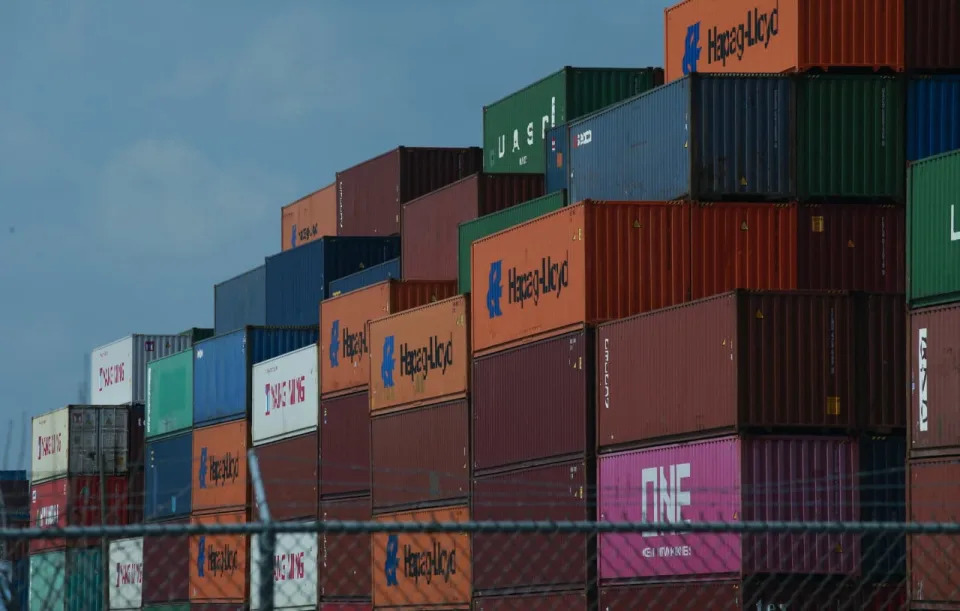
“Tariff Man” is back, sending shock waves through the foreign-exchange market but leaving major U.S. stock indexes largely unmoved — at least for now.
President-elect Donald Trump indicated he was ready to follow through on a campaign pledge on his first day back in office, announcing Monday night that he would slap 25% tariffs on imports from Mexico and Canada , and an additional 10% on those from China.
The pronouncement by Trump, who in 2018 described himself as “a Tariff Man,” served to bring back memories of his first term, “when such events provided trading direction and meaningful (if unpredictable) market influence,” said Ian Lyngen, rates strategist at BMO Capital Markets, in a note. But while the announcement served to sink the Mexican peso USDMXN and the Canadian dollar USDCAD, investors elsewhere were taking the move largely in stride.
Need to Know: There’s more room for risk assets to rally — focus on policy, not politics, HSBC says
That calm, particularly in the Treasury market, likely reflects how investors should have been little surprised given Trump’s emphasis on tariffs on the campaign trail, Lyngen said. The reaction indicates that “not only had the market already priced in a renewed emphasis on ‘tariffs as trade policy’, but it’s also an acknowledgment that increases in levies have a one-time impact on realized inflation,” he wrote.
Moreover, tariffs also carry the risk of undermining demand and shifting the trajectory of what remains a remarkably resilient U.S. economy, he added.
The yield on the 10-year Treasury note BX:TMUBMUSD10Y was up around 4.5 basis points Tuesday to near 4.311%, lifted after a U.S. consumer-confidence reading . Yields, which move opposite to prices, had initially risen Tuesday after Trump’s announcement before pulling back. They retreated sharply in Monday’s session after Trump’s decision to nominate hedge-fund manager Scott Bessent as Treasury secretary; the 10-year yield dropped nearly 15 basis points on Monday, its biggest one-day decline since Aug. 2, according to Dow Jones Market Data.
Relatively calm rates left room for stocks to edge mostly higher.
The S&P 500 SPX was rising 0.4% Monday early afternoon to trade back above the 6,000 threshold and was on track for a record finish, while the Nasdaq Composite COMP was up 0.6%. The Dow Jones Industrial Average DJIA was down around 70 points, or 0.2%, after a record close on Monday.
Investors, of course, can look back on Trump’s first term as they attempt to game out the potential market reaction to a new round of tariffs, assessing their implications for growth and inflation.
Tariffs make imports more expensive, diverting spending to domestic production and to imports from countries that aren’t affected by the levies, noted economists at Oxford Economics in a note this month. That implies higher prices in the country imposing the tariffs and lower growth in both the tariff-imposing country and those hit by the tariffs.
They noted that evidence from the U.S.-China trade war that erupted during Trump’s first term that shows tariffs can have a big negative impact on bilateral trade flows — with every 1-percentage-point rise in tariffs cutting imports from China by 2.5%. The impact on inflation, however, was small due to the U.S. being a relatively closed economy, retailers absorbing some of the effects and U.S. demand shifting to imports from elsewhere.
They estimated that raising tariffs on all Chinese goods to 60% would add at most 0.7% to the U.S. consumer-price index.
Read: 10 key takeaways for investors from Trump’s latest tariff threats
What’s more, the impact on inflation is likely to be a one-time hit barring a tit-for-tat series of escalations, Rob Arnott, founder and chairman of investment-advisory firm Research Associates, told MarketWatch earlier this month.
“The math on tariffs suggest that it would move the needle not a lot,” Arnott said.
That said, concerns about a fresh boost in inflation via tariffs may have served to help lift Treasury yields in the run-up to Trump’s victory and immediately afterward, he noted, along with concerns that the Federal Reserve eased interest rates too aggressively this fall in the face of a robust economy.
Some economists see room for tariffs to dent expectations for future Fed rate cuts.
“The Fed is likely to slow or stop cutting interest rates in response to a tariff shock of this magnitude, waiting to see what the impact on prices will be,” said Carl Weinberg and Rubeela Farooqi, economists at High Frequency Economics, in a Tuesday note.
They noted that Trump’s 2018-19 tariff increases didn’t move the CPI perceptibly higher, but that those levies were imposed relatively gradually and weren’t across the board.
“With or without a Fed response, real incomes in the United States will fall if these tariffs are implemented as stated by the president-elect, and GDP will be reduced. If the Fed does end up holding rates higher for longer, GDP will be further reduced. If tariffs trigger price instability, higher inflation would also reduce GDP growth,” the economists wrote.
At the same time, it remains unclear if the proposed tariffs are likely to stick or are meant more as a negotiating tactic, they acknowledged. Analysts said that ambiguity may also have blunted the impact of the announcement when it comes to U.S. markets.
Trump said the new tariffs would remain in place until the flow of illegal drugs, including fentanyl, and illegal immigration into the U.S. were halted.
“The implication seems to be that the countries could avoid these tariffs by presenting credible plans to take action to reduce drug supply or secure their borders, much like how Mexico staved off a similar threat from Trump in 2019,” said Stephen Brown, deputy chief North America economist at Capital Economics, in a note.

